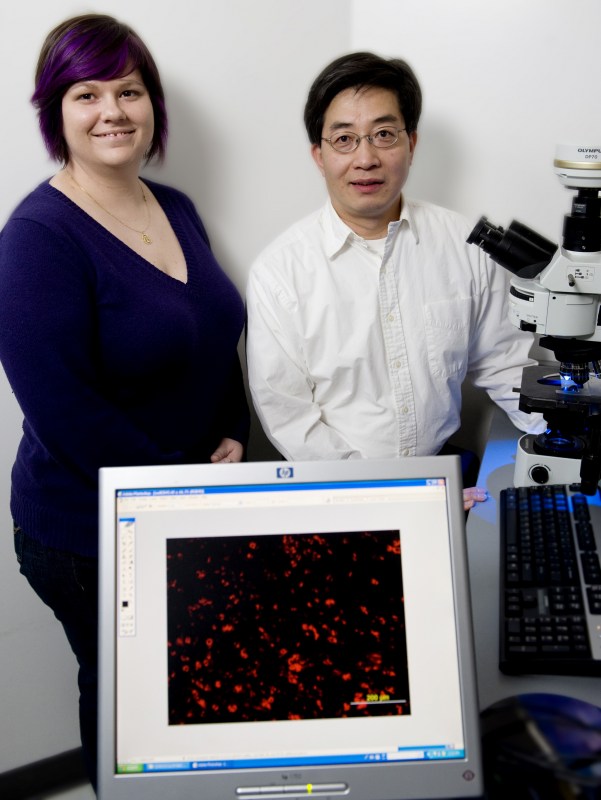
Charles Lin, Ph.D., and graduate student Kimberly Covington in the lab at the Preston Research Building. (photo by Joe Howell)
New target for severing cancer’s access to supplies
Tissue growth — in normal development and in disease conditions such as cancer — relies on new blood vessels to bring in “supplies.”
Researchers at Vanderbilt University Medical Center have identified a new protein that participates in building blood vessels, a process called angiogenesis, during disease conditions, but not during normal physiological processes.
They report in the January issue of the Journal of Experimental Medicine that lowering levels of the protein, delta-catenin, halts tumor formation and wound healing in mice.
“Because delta-catenin specifically regulates pathological angiogenesis and has no effect on physiological angiogenesis, we think it may be a better therapeutic target for blocking blood vessel growth in disease conditions like cancer,” said Charles Lin, Ph.D., associate professor of Radiation Oncology, Cancer Biology and Cell & Developmental Biology.
Delta-catenin is a member of the family of p120 proteins, which participate in cell adhesion and were first identified by Albert Reynolds, Ph.D., at Vanderbilt. Delta-catenin was thought to be mainly in neuronal cells, until Lin and his team found it in endothelial cells (the cells that line blood vessels).

To explore a possible role for delta-catenin in angiogenesis, Lin and his colleagues used mice missing one or both copies of the delta-catenin gene.
Endothelial cells from the mice missing delta-catenin (one or both gene copies) had reduced cell motility and vascular structure formation, compared to cells from normal mice.
In models of tumor growth and wound healing, tumor growth and blood vessel density were reduced, and angiogenesis and wound closure were impaired in mice missing one or both copies of delta-catenin. In contrast, mice missing the delta-catenin gene had normal physiological hormone-induced angiogenesis in the uterus.
The fact that the defects in pathological angiogenesis are similar in mice missing only one copy of the delta-catenin gene (they still have one normal copy) and mice missing both copies suggests that the levels of delta-catenin are critical to its function in angiogenesis, Lin said.
“Only a very small number of genes have this type of gene dosage effect,” Lin said. “Delta-catenin may be a very sensitive target for therapeutics because even partial inhibition produces a response.”
Evidence from human beings supports this gene dosage effect, Lin noted. Patients with Cri-du-chat syndrome are missing one copy of the delta-catenin gene and have developmental delays, neuronal defects and congenital heart defects. The current findings that delta-catenin has a role in endothelial cell motility may explain the heart defects.
Lin and his colleagues also demonstrated that inflammatory signals, such as TNF-alpha and interleukin-1, increase delta-catenin expression in human endothelial cells in culture. The investigators propose that inflammation is the key difference between physiological and pathological angiogenesis.
“Our model is that in disease conditions, or tissue injury, the first response is inflammation,” Lin said. “Inflammatory cytokines then increase delta-catenin expression, which controls endothelial cell motility and pathological angiogenesis.”
Consistent with this model, the investigators found increased levels of delta-catenin in human lung cancer samples, compared to normal lung tissue.
Lin and his team plan to collaborate with Vanderbilt's Program in Drug Discovery to develop inhibitors of delta-catenin or its signaling partners. Such inhibitors, he said, would be good leads for medications to treat cancer and other diseases where blood vessels overgrow, such as rheumatoid arthritis and retinopathy, a major cause of blindness.
Co-authors of the new study, which was featured on the journal cover, include Laura DeBusk, Ph.D., Kimberly Boelte and Yongfen Min, M.D., Ph.D. The research was supported by the National Institutes of Health.













